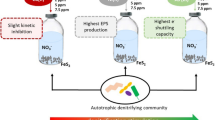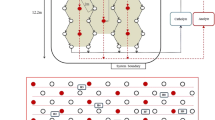Abstract
Comparisons on the bioleaching and sterile oxidation of pyrite were performed at controlled redox potential of 900 mV (vs. SHE) and different temperatures of 30 and 60 °C. For sterile experiments, the redox potential of irrigation solution was controlled by adding hydrogen peroxide solution (15 wt%), while the redox potential of irrigation solution for bioleaching was elevated by flowing through the packed bed in which bacteria were activated and colonized. The rate of pyrite bioleaching is faster than that of sterile oxidation at temperature of 30 °C. The reason is that the potential gradient of leaching solution in bioleaching column is much smaller than that in sterile column. The redox potentials of irrigation solution and leaching solution are similar for bioleaching; however, the redox potential difference of irrigation solution and leaching solution for sterile oxidation is about 150 mV. When temperature increases to 60 °C for sterile oxidation, the rate of pyrite leaching is faster than that of bioleaching at temperature of 30 °C, even though the redox potential gradient of leaching solution is great. The mineralogy analyses of pyrite residue were performed by scanning electron microscopy–energy-dispersive spectroscopy (SEM–EDS), X-ray diffraction (XRD) and X-ray photoelectron spectroscopy (XPS) analyses. The results confirm that pyrite oxidation might only occur at specific sites with high surface energy on surface and obeys the “indirect mechanism” whether there are bacteria or not. The pyrite oxidation rate is not inhibited by inert sulfur on residue surface at elevated redox potential. According to the conclusions, the way to accelerate pyrite oxidation is proposed.









Similar content being viewed by others
References
Dimitrijevic M, Antonijevic MM, Jankovic Z. Kinetics of pyrite dissolution by hydrogen peroxide in perchloric acid. Hydrometallurgy. 1996;42(3):377.
Ruan RM, Zhou E, Liu XY, Wu B, Zhou GY, Wen JK. Comparison on the leaching kinetics of chalcocite and pyrite with or without bacteria. Rare Met. 2010;29(6):552.
Valente TM, Leal Gomes C. Occurrence, properties and pollution potential of environmental minerals in acid mine drainage. Sci Total Environ. 2009;407(3):1135.
Iglesias N, Carranza F. Treatment of a gold bearing arsenopyrite concentrate by ferric sulphate leaching. Miner Eng. 1996;9(3):317.
Deng TY, Liao MX. Gold recovery enhancement from a refractory flotation concentrate by sequential bioleaching and thiourea leach. Hydrometallurgy. 2002;63(3):249.
McKibben MA, Barnes HL. Oxidation of pyrite in low temperature acidic solutions: rate laws and surface textures. Geochim Cosmochim Acta. 1986;50(7):1509.
Moses CO, Kirk Nordstrom D, Herman JS, Mills AL. Aqueous pyrite oxidation by dissolved oxygen and by ferric iron. Geochim Cosmochim Acta. 1987;51(6):1561.
Nicholson RV, Gillham RW, Reardon EJ. Pyrite oxidation in carbonate-buffered solution: 1. Experimental kinetics. Geochim Cosmochim Acta. 1988;52(5):1077.
Holmes PR, Crundwell FK. The kinetics of the oxidation of pyrite by ferric ions and dissolved oxygen: an electrochemical study. Geochim Cosmochim Acta. 2000;64(2):263.
Sand W, Gehrke T, Jozsa PG, Schippers A. (Bio) chemistry of bacterial leaching—direct vs. indirect bioleaching. Hydrometallurgy. 2001;59(2–3):159.
Tributsch H. Direct versus indirect bioleaching. Hydrometallurgy. 2001;59(2–3):177.
Heidel C, Tichomirowa M. The isotopic composition of sulfate from anaerobic and low oxygen pyrite oxidation experiments with ferric iron—new insights into oxidation mechanisms. Chem Geol. 2011;281(3):305.
Basson P, Gericke M, Grewar TL, Dew DW, Nicol MJ. The effect of sulphate ions and temperature on the leaching of pyrite. III. Bioleaching. Hydrometallurgy. 2013;133:176.
Garrels RM, Thompson ME. Oxidation of pyrite by iron sulfate solutions. Am J Sci. 1960;258-A:57.
Singer PC, Stumm W. Acidic mine drainage: the rate-determining step. Science. 1970;167(3921):1121.
Boon M, Brasser HJ, Hansford GS, Heijnen JJ. Comparison of the oxidation kinetics of different pyrites in the presence of Thiobacillus ferrooxidans or Leptospirillum ferrooxidans. Hydrometallurgy. 1999;53(1):57.
May N, Ralph DE, Hansford GS. Dynamic redox potential measurement for determining the ferric leach kinetics of pyrite. Miner Eng. 1997;10(11):1279.
Ruitenberg R, Hansford GS, Reuter MA, Breed AW. The ferric leaching kinetics of arsenopyrite. Hydrometallurgy. 1999;52(1):37.
Chandra AP, Gerson AR. The mechanisms of pyrite oxidation and leaching: a fundamental perspective. Surf Sci Rep. 2010;65(9):293.
Sun HY, Chen M, Zou LC, Shu RB, Ruan RM. Study of the kinetics of pyrite oxidation under controlled redox potential. Hydrometallurgy. 2015;155:13.
Chandra AP, Gerson AR. Redox potential (Eh) and anion effects of pyrite (FeS2) leaching at pH 1. Geochim Cosmochim Acta. 2011;75(22):6893.
Nicol M, Miki H, Basson P. The effects of sulphate ions and temperature on the leaching of pyrite. 2. Dissolution rates. Hydrometallurgy. 2013;133:182.
Li QC, Li DX, Qian FJ. Pre-oxidation of high-sulfur and high-arsenic refractory gold concentrate by ozone and ferric ions in acidic media. Hydrometallurgy. 2009;97(1):61.
Lefticariu L, Schimmelmann A, Pratt LM, Ripley EM. Oxygen isotope partitioning during oxidation of pyrite by H2O2 and its dependence on temperature. Geochim Cosmochim Acta. 2007;71(21):5072.
Lizama HM. A kinetic description of percolation bioleaching. Miner Eng. 2004;17(1):23.
Schippers A, Sand W. Bacterial leaching of metal sulfides proceeds by two indirect mechanisms via thiosulfate or via polysulfides and sulfur. Appl Environ Microbiol. 1999;65(1):319.
Nesbitt HW, Muir IJ. X-ray photoelectron spectroscopic study of a pristine pyrite surface reacted with water vapour and air. Geochim Cosmochim Acta. 1994;58(21):4667.
Nesbitt HW, Bancroft GM, Pratt AR, Scaini MJ. Sulfur and iron surface states on fractured pyrite surfaces. Am Mineral. 1998;83:1067.
Schaufuß AG, Nesbitt HW, Kartio I, Laajalehto K, Bancroft GM, Szargan R. Reactivity of surface chemical states on fractured pyrite. Surf Sci. 1998;411(3):321.
Nesbitt HW, Scaini M, Hochst H, Bancroft GM, Schaufuss AG, Szargan R. Synchrotron XPS evidence for Fe2+-S and Fe3+-S surface species on pyrite fracture-surfaces, and their 3D electronic states. Am Mineral. 2000;85(5–6):850.
Harmer SL, Thomas JE, Fornasiero D, Gerson AR. The evolution of surface layers formed during chalcopyrite leaching. Geochim Cosmochim Acta. 2006;70(17):4392.
Chandra AP, Gerson AR. Pyrite (FeS2) oxidation: a sub-micron synchrotron investigation of the initial steps. Geochim Cosmochim Acta. 2011;75(20):6239.
Logan TC, Seal T, Brierley JA. Whole-Ore Heap Biooxidation of Sulfidic Gold-Bearing Ores. Biomining: Springer; 2007. 113.
Modak JM, Natarajan KA, Mukhopadhyay S. Development of temperature-tolerant strains of Thiobacillus ferrooxidans to improve bioleaching kinetics. Hydrometallurgy. 1996;42(1):51.
Franzmann PD, Haddad CM, Hawkes RB, Robertson WJ, Plumb JJ. Effects of temperature on the rates of iron and sulfur oxidation by selected bioleaching bacteria and archaea: application of the Ratkowsky equation. Miner Eng. 2005;18(13):1304.
Acknowledgements
This work was financially supported by the Research Fund for Program of Efficient Gold Extraction from Refractory Gold Ore of Sichuan Province, China (No. 12120113088100), the National Natural Science Foundation of China (Nos. 41401541 and 51474075) and the Bureau of International Co-operation, Chinese Academy of Sciences (No. 122111KYSB20150013). The authors are grateful to Professor Miao Chen for XPS analyses.
Author information
Authors and Affiliations
Corresponding author
Rights and permissions
About this article
Cite this article
Sun, HY., Tan, QY., Jia, Y. et al. Pyrite oxidation in column at controlled redox potential of 900 mV with and without bacteria. Rare Met. 41, 4279–4288 (2022). https://doi.org/10.1007/s12598-016-0844-y
Received:
Revised:
Accepted:
Published:
Issue Date:
DOI: https://doi.org/10.1007/s12598-016-0844-y




